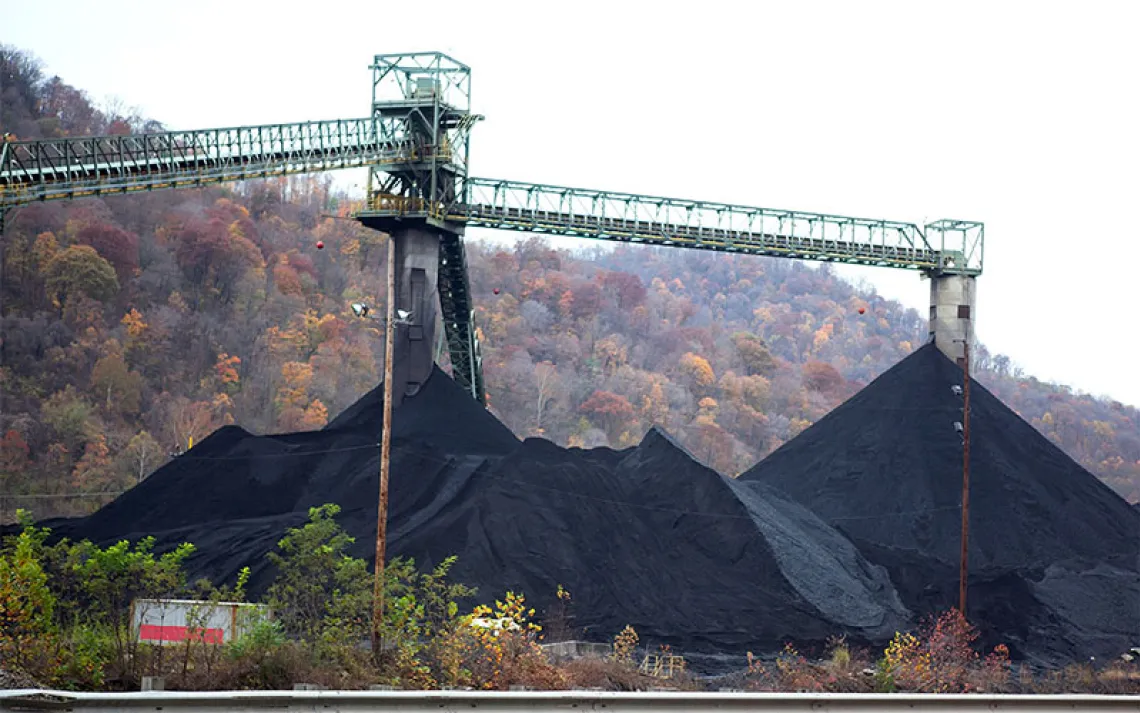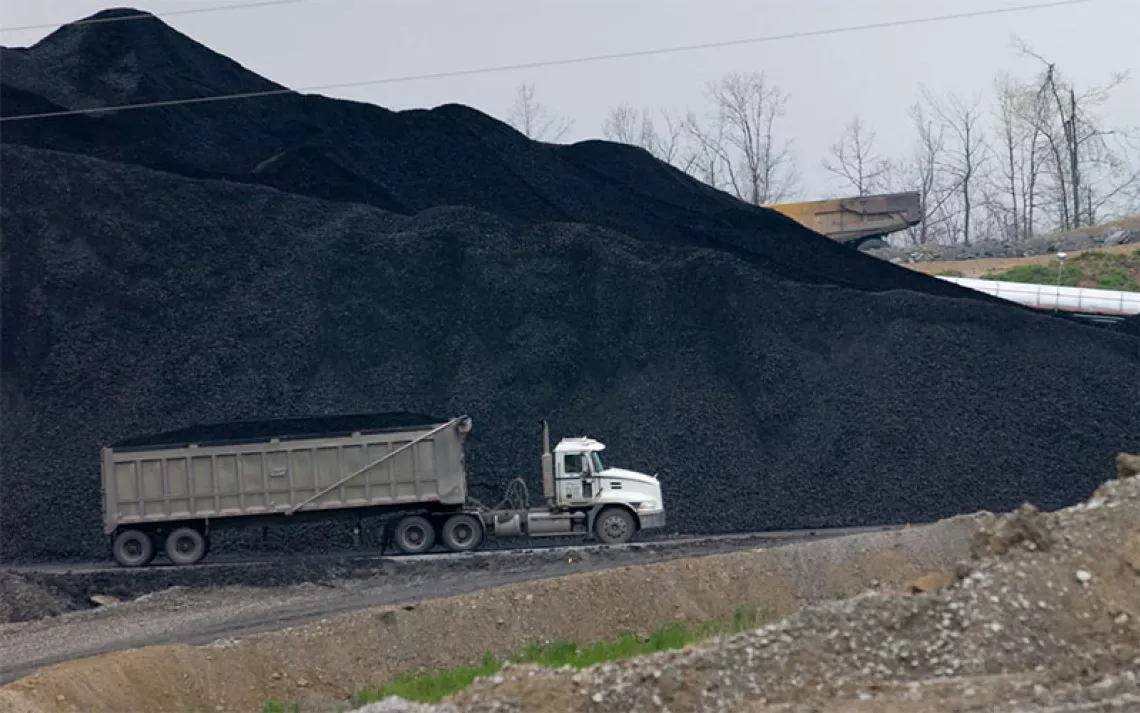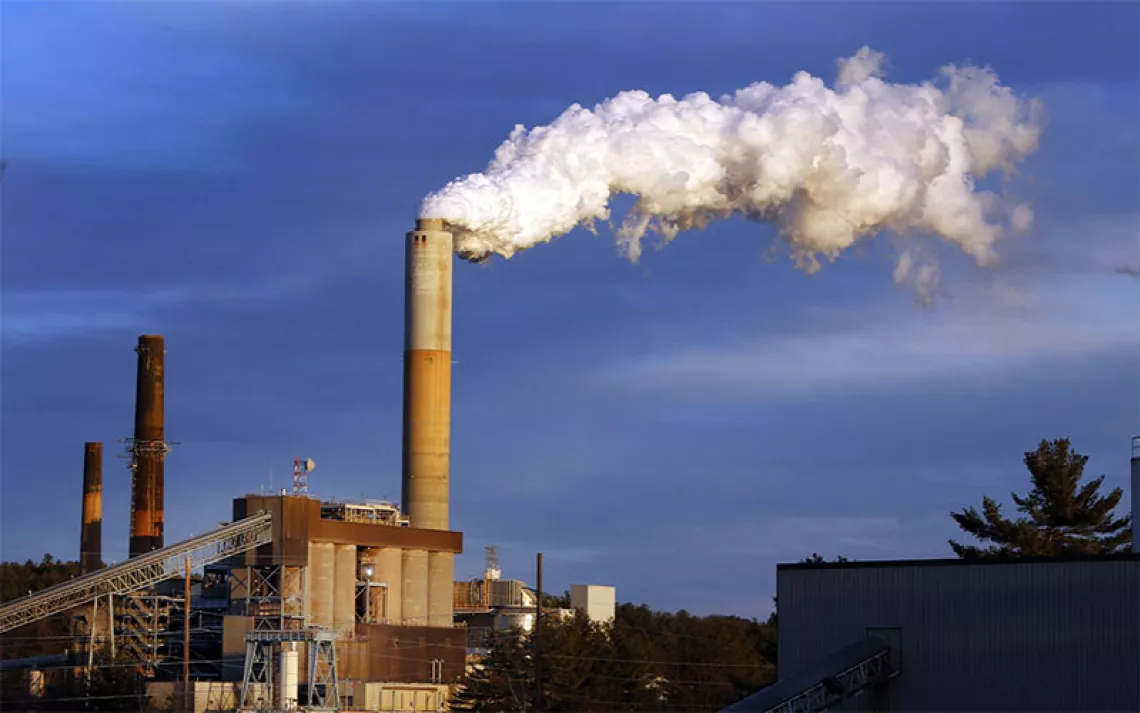Germany Has a Major Dirty Coal, and Climate, Problem
A fight for climate justice over a tiny German forest brimming with biodiversity

Photos by Maurice Frank
On a mild October evening, the sun sinks over a barren pit that stretches as far as the eye can see.
The steaming towers of two enormous power plants on the horizon serve as a reminder that this eerie landscape is in the middle of Germany and not some other planet.
This is the edge of the Hambach open-cast lignite, or brown coal, mine, 19 miles west of Cologne between the Rhine River and the Dutch border. Around two dozen protesters are huddled on the drop-off. Approximately 100 feet in front of them, the huge circular shovel of a 300-foot-tall excavator, one of the largest machines on Earth, has stopped rotating in mid-air. A man in bright-orange overalls, an employee of the energy company RWE, is shouting something at the group, but it gets lost in the wind.
The Hambach mine, the largest of its kind in Europe, is ground zero for the German climate movement: The mine produces 44 million tons of lignite per year. In terms of carbon emissions, lignite is one the dirtiest fossil fuels. Germany is well known for its “energy transition” to renewables, but still burns 188 million tons of lignite per year to generate power. In 2017, burning lignite produced nearly a quarter of electricity in Germany. That number rises to 37 percent if you include black coal.
A short hike across a wasteland of tree stumps and churned mud to the south is Hambach Forest. Or what's left of it. Unlike pit mining, open-cast lignite extraction means removing everything on the surface of the earth—trees, villages, fields, highways—and then a thousand more feet of earth and rock to reach a layer of lignite. Before RWE began mining here in 1978, the forest stretched over more than 4,000 acres. Now just 500 acres are left. Clearcutting those remaining 500 is essential to RWE's plan to expand its mine—one of three in the region—southward. Tens of millions of tons of valuable coal lie far beneath the trees.
Despite its commitment to the 2015 Paris Agreement, Germany has failed to reduce its greenhouse emissions for the last nine years. Chancellor Angela Merkel's government recently announced it would miss its 2020 emissions target of a 40 percent reduction over 1990 levels by a wide margin.
Activists have resorted to civil disobedience in response to the lack of government climate action. In 2012, a few young Germans built treehouses high up in the beeches and oaks of the forest and lived in them year-round. Police periodically evicted the squatters, but they kept returning in greater numbers. By summer 2018, occupiers had built about 80 dwellings, some as high as 80 feet from the ground.

Sign up to receive Sierra News & Views
Get articles like this one sent directly to your inbox weekly.
With this action you affirm you want to receive Sierra Club communications and may vote on policy designated by the Sierra Club Board.


One of the earliest squatters was a young man calling himself “Clumsy.” During a “Climate Camp” activist meeting in 2015, he said, “Our main tactic is tree sits. We're putting our bodies in the line against this project.”
According to Clumsy, other tactics include rail blockades, occupying the excavators, and sabotaging equipment—old-school monkeywrenching. RWE periodically reports low-level vandalism of its property, but nothing has been more effective than the nonviolent occupation.
In August, RWE announced it would begin logging by mid-October. The state of North Rhine Westphalia obtained a court order to evict the tree-sitters on the absurd grounds that the treehouses didn't meet fire-safety standards. Specialist climbers were sent in to painstakingly extract the squatters. Thousands of police were bussed in to guard the forest perimeter 24 hours a day.
The evictions attracted daily media coverage and stoked public sympathy. A survey found that 75 percent of Germans opposed the logging. Every weekend in September, more people headed to the forest to protest.
One of them, referring to herself only as Sandra, is from Cologne. “This display of power by the state government really worked me up and led me to take a closer look at what was going on. I wasn't an environmental activist beforehand. The evictions of the treehouses moved me to get involved.”

More media showed up when, in mid-September, a young video blogger died after falling from a rope bridge that the occupiers had built between trees.
Even members of the police force chimed in with criticism of the operation. In an anonymous online letter, one officer wrote, “Why are we washing the laundry of a multibillion-euro corporation which, against all common sense and without any regard, is destroying a huge habitat, for one of the dirtiest forms of energy?”
In a part of the world where most old-growth forests were cut down long ago, Hambach has never been significantly impacted.
“Since the end of the ice age 12,000 years ago, the forest has always been there,” says Dirk Jensen, director of the North Rhine Westphalia branch of the environmental organization BUND. “It was never subjected to intense forestry.”
According to legend, around 800 A.D., Emperor Charlemagne gifted the forest to court singer Arnold von Arnoldsweiler in a bet during a hunting expedition. Von Arnoldsweiler gave it to the surrounding communities as an act of charity. By the Middle Ages, the forest was parceled into Allmenden, or collectively owned commons. Community leaders met regularly to decide how much timber could be harvested, meaning Hambach was managed sustainably for centuries. The arrangement essentially lasted until the 20th century, when lignite was discovered. In the 1970s, RWE purchased the forest from local villages. Digging began in 1978, and the woodland has successively shrunk ever since.
“According to the latest studies,” says Jensen, “nearly 2,000 different species of beetle inhabit the forest, because there is a lot of dead wood. It's believed that 13 species of bat live there. What is extraordinary is that we have two nursery roosts of the endangered Bechstein's bat, with approximately 90 adult females in two colonies, where they give birth to their offspring in the summer. This is the largest population of this strictly protected species within a radius of 300 kilometers.” The forest is botanically unique as well, says Jensen. “It is the largest lasting example of the European habitat made up of oaks, hornbeams, and lilies of the valley.”
Because of this biodiversity, Jensen says, “it's undisputed that the forest meets the criteria of a fauna and flora conservation area under the 1992 EU Habitats Directive. The forest should have been registered with the European Union in the 1990s or at the latest when the Bechstein's bats were discovered in 2005.”
Registering the habitat would have meant a halt to mining. Jensen suspects the government deliberately neglected to do so due to economic interests.
Amid growing public outrage, BUND filed a lawsuit against RWE in September, claiming that Hambach should be classified as a protected area under the EU Habitats Directive. On October 5, the Higher Administrative Court in Münster ordered the company to suspend logging until the case was properly reviewed. RWE responded by issuing a profit warning, saying it would probably have to suspend clearance of forest until at least 2020, halting expansion of the lignite mine itself.
Jensen puts it this way: “The tiny little Bechstein's bat is playing a pretty central role in the struggle for the transition to renewable energy. These are fascinating times.”
The very next day, on October 6, 50,000 people from across Germany and neighboring countries gathered in an adjacent field to demonstrate and celebrate the court decision. Jubilant speakers spoke about the dawn of a new mass environmental movement. Undisturbed by police, activists began building new treehouses and barricades.
So when will Germany finally stop burning coal? Last spring, Merkel, under pressure to finally do something about climate change, set up the Coal Commission, a roundtable of industry representatives, NGOs, and unions, to come up with a schedule for phasing out coal. At stake are 20,000 mining jobs and a long-neglected investment plan for affected regions. Companies like RWE want to burn lignite until mid-century while BUND and other NGOs are pushing for an end date of 2025. Jensen says 10 gigawatts worth of lignite power generation could be taken offline immediately without affecting electricity supply—and Germany would still stand a chance of meeting its 2020 emissions targets. It's expected that a compromise between the two positions will be announced mid-December.
Internationally, Germany needs to show the world it has a credible climate policy.
“At the COP24 climate conference taking place December 3 to 14 in Poland, there'll be a rude awakening,” Jensen says. “We will have to announce to the world that we missed our own climate goals. There won't be much left of Germany's aura as 'land of the energy transition.'”
Despite the temporary halt on logging in Hambach Forest, activists are keeping up the pressure. In late October, thousands occupied the mine and blocked RWE coal trains for the good part of a weekend. At the same time, the miners' labor unions, supported by RWE, have begun staging their demonstrations. Germany's battle over coal is far from over.
 The Magazine of The Sierra Club
The Magazine of The Sierra Club



